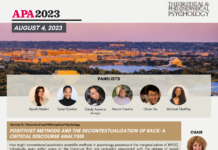A recent study, published in the Journal of the Society for Social Work and Research, investigates the psychometric properties of the CES-D, a screening tool designed to measure depression, when applied to a sample of Black adolescents. The tool was developed in mainly White adults, and the cross-cultural validity of the test has come into question. The results of their study indicate that the CES-D may be inadequate for assessing depression in people of color.
Lu and colleagues also explore the nuances in the way Black adolescents may experience and express symptoms of depression. They emphasize that environmental factors must be considered in the expression of depression in Black adolescents.
“Assessing the psychological impact of depression using context-level psychosocial effects, individual coping styles, recognizing how adolescents assign meaning to their stressful developmental experiences, and addressing resiliency will assist clinicians in comprehensive assessment and treatment of depression among Black adolescents.”

This study is the first to examine the cross-cultural validity of the CES-D in Black adolescents, a population reportedly under-investigated and at risk for being overdiagnosed and/or misdiagnosed. Though conflicting findings have been reported on racial disparities in the prevalence of adolescent depression, research has consistently found an exponential increase in rates of suicide among Black youth.
Augmenting these concerns is the reality that our current assessment scales might fail to understand this population’s lived experiences. The CES-D has already been shown to vary significantly among racial and ethnic groups, suggesting that “marked differences may exist in the conceptualization of depression among non-White racial/ethnic groups.”
To preclude the dissemination of a scale that lacks cross-cultural validity and risks missing the narratives of non-White populations, Lu et al. seek to “identify ways Black adolescents express their symptoms, determine any gender differences in symptom expression, and calibrate existing assessment tools to improve their psychometric properties for this population.”
For this study, the CES-D was administered in nine public housing developments within four major U.S. cities in order increase generalizability. Through respondent-driven sampling, a method that encourages participants to invite up to three referrals, a total of 792 Black/African American identifying adolescents (47.6% girls; 51.9% boys) between the ages of 11-21 completed the original 20-items included in the CES-D, along with a questionnaire to measure suicidal ideation.
On an adjusted scaling for adolescents, minimal depression scored between 0-15, mild depressive symptoms 16-23, and moderate/severe depressive symptoms 24+. The mean score for the sample was 15.17 with over half of the adolescents scoring 0-15, 17.4% indicating mild symptoms, and around one-quarter exhibiting moderate/severe symptoms based on the CES-D. Thirty-nine participants reported they seriously considered attempting suicide in the last 12 months, and thirty endorsed having a suicide plan.
The researchers were interested in learning from the data what was useful about the CES-D. Through the results mentioned above, they concluded that a two-factor structure is more appropriate for Black youth living in public housing than the original four-factor structure, factor 1 emerging from a “lack of distinction between depressed affect, somatic complaints, and interpersonal relations items among Black adolescents as these items grouped into one factor study.”
The researchers note that this proclivity to express depressive symptoms in somatic complaints is well documented in other minority populations, i.e. American Indians, Mexican Americans, and Filipino Americans. The failure to distinguish interpersonal relations from depressed affect and somatic complaints could be rooted in racial discrimination, though more research is warranted to make that claim.
Factor 2 is described as different interpretations of positive affect than those of adults and can be understood as a developmental differential in the perceptions of the participants, verifying the importance of considering age when determining appropriate psychometric measurements. Finally, Lu and colleagues incorporate the influence of gender and environment on test results, noting both the ambiguous but essential role these factors play.
They write that their study results “might reflect the deleterious effect of living in a stressful context such as public housing, revealing that environment’s link to depression and suicidal behaviors among Black adolescents.”
The lack of data for Black adolescents across varying socioeconomic situations limits the generalizability of this study, and more research is warranted involving a more diverse Black adolescent sample.
Lu et al. conclude with clinical implications encouraging clinicians and caretakers to be aware of differences in the way Black adolescents express depressive symptoms and the nuances that can exist within that population:
“Clinicians should closely examine the relationship between individual, social, environmental, and cultural factors when assessing the psychological impact of depression among Black adolescents. Because depression presents differently for these young people, it is important to allow the adolescents to use their terminology when describing their depressive symptoms. It is equally important for clinicians to be aware of gender differences in the expression of depression.”
****
Lu, W., Lindsey, M. A., Irsheid, S., Nebbitt, V. E. (2017). “Psychometric properties of the CES-D among black adolescents in public housing. Journal of the Society for Social Work and Research, 8 (4): 595-619. (Link)















Trying to sell more drugs or trying to sell less drugs?
Report comment
And who exactly are they accurate FOR?
Report comment
Hello Hannah. You must be new here.
Report comment
Hannah has been writing here since September 2017.
Report comment
Funny. You would think she’d be more familiar with MIA’s philosophy by now.
Report comment
MIA’s whatnow, lol?
Report comment
When I took the Minnesota Muliphasic Fuckup Test in 1982, I noticed a culturally biased question on the test. The test asked a question that used a phrase that I had never heard before. As it turned out, this was a colloquial expression never used in New England, where I was raised. Likely it was used in the Midwest or the South, but I had no clue what it meant. I also noticed assumptions of a two-parent family, assumptions you went to a classroom school, assumptions of ableism, and that you knew a few things about Easter. Since then I believe researchers have noticed the biases. NOTE: It may not have been that test but another one…I am recalling a Y/N test I did with a #2 pencil.
Even back then, I believed the inkblot test was totally bogus.
When I was all done with these tests I went back to my therapist and complained that the tests had no relevance to my eating disorder and didn’t address the issue. Nowadays, I wish I had said that a whole lot louder.
Report comment